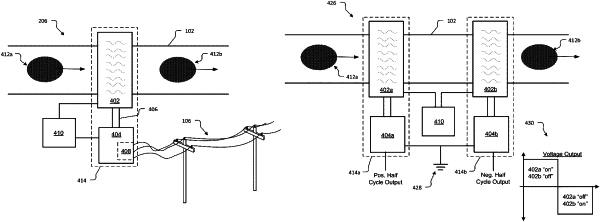| CPC H02J 50/20 (2016.02) [H02N 3/00 (2013.01); H05H 15/00 (2013.01)] | 13 Claims |

|
1. An energy extraction system comprising:
a decelerator cavity coupled to a transport line for a charged particle beam, the decelerator cavity configured to extract energy from the charged particle beam traveling through the decelerator cavity as RF energy and comprising an active dielectric that, in response to a control signal, actively controls a resonance frequency of the decelerator cavity;
an energy conversion device coupled to the decelerator cavity, the energy conversion device configured to convert the RF energy into electrical current and supply the electrical current to an electric power grid, and
a control system configured to selectively couple and decouple decoupled the decelerator cavity with the charged particle beam in response to electrical power demand of an electrical load coupled to the energy extraction system by selectively tuning and detuning the decelerator cavity to a resonant frequency of the charged particle beam, the selectively tuning comprising:
adjusting the control signal applied to the active dielectric to tune the decelerator cavity to a first resonance frequency that is the resonance frequency of the charged particle beam to couple the decelerator cavity to the charged particle beam; and
further adjusting the control signal applied to the active dielectric to de-tune the decelerator cavity to a second resonance frequency that is not the resonance frequency of the charged particle beam to decouple the decelerator cavity from the charged particle beam,
wherein the charged particle beam comprises charged particles with individual rest masses greater than the rest mass of an electron.
|
|
11. An energy extraction system comprising:
a decelerator cavity coupled to a transport line for a charged particle beam, the decelerator cavity configured to extract energy from the charged particle beam traveling through the decelerator cavity as RF energy and comprising an active dielectric that, in response to a control signal, actively controls a resonance frequency of the decelerator cavity;
means for converting the RF energy into electrical current and supplying the electrical current to an electric power grid, wherein the means is coupled to the decelerator cavity, and
a control system configured to selectively couple and decouple decoupled the decelerator cavity with the charged particle beam in response to electrical power demand of an electrical load coupled to the energy extraction system by selectively tuning and detuning the decelerator cavity to a resonant frequency of the charged particle beam, the selectively tuning comprising:
adjusting the control signal applied to the active dielectric to tune the decelerator cavity to a first resonance frequency that is the resonance frequency of the charged particle beam to couple the decelerator cavity to the charged particle beam; and
further adjusting the control signal applied to the active dielectric to de-tune the decelerator cavity to a second resonance frequency that is not the resonance frequency of the charged particle beam to decouple the decelerator cavity from the charged particle beam,
wherein the charged particle beam comprises charged particles with individual rest masses greater than the rest mass of an electron.
|